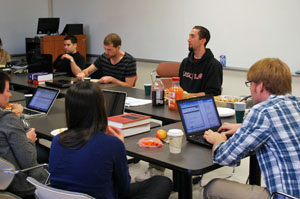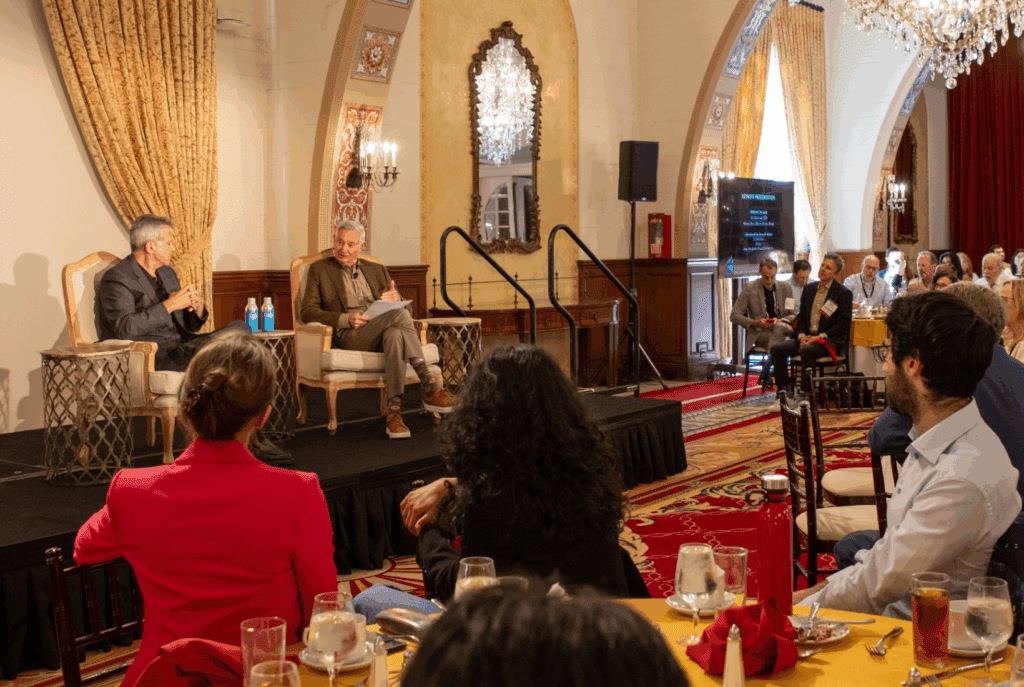Privacy and drones: Who draws the line?
“The drone is safe enough for just about anyone to fly and enjoy but it's also highly customizable. You can set the max height it will fly and even adjust how fast it goes by adjusting the tilt angle. Believe me, this baby will MOVE… You can post videos straight to YouTube or just keep them for yourself with the flight metric data. It's a cool nerd point!”
Although Brookstone shoppers like this one praise a drone quadricopter in online reviews,most Americans might be too enthralled with toys to realize that similar technology can be used in their own backyards -- literally. Both the toy drone and the drone models used by law enforcement in the U.S. can be remote-controlled and are customizable and surveillance-capable.
People may be excited about the drones they can buy online, but how will they feel about drones that can monitor them outside their windows?
 |
| Ben Jakovljevic '14 (center) discusses his research on domestic drone use. |
The American Civil Liberties Union (ACLU) at USC Gould recently hosted a discussion on the United States’ use of drone technology and its implications for civil liberties and personal privacy.The panel included Prof. Seth Stodder, a USC Gould Lecturer in Law and expert on counterterrorism and homeland security and several ACLU@USC members. ACLU@USC Treasurer Ben Jakovljevic ’14 jokingly asked attendees if they had done the required reading for the discussion; Jakovljevic's research on the use of drones by the U.S. to monitor the Mexican border and Mexican drug cartels inspired the event.
Minku Kang ’14, the group’s vice president for public affairs, said he was most concerned with Fourth Amendment issues with respect to domestic drone use by law enforcement. How drones can be used is still in question.
“The biggest thing holding back widespread use is the FAA regulations,” Kang said. “When the rules come out in 2015, it will be made clear who can use them.”
When discussing the standards surrounding the discussion, students cited cases such as U.S. v. Jones, Killo v. United States and U.S. v. Knotts. Although each case brought surveillance precedents to the table, U.S. v. Katz set the standard for a reasonable expectation of privacy. Brendan Charney ’13 said drone use was just an extension of human capability.
“These are capabilities we’ve always had,” Charney said. “Technology just makes it easier to do these things.”
Stodder, who teaches Homeland Security and Counterterrorism Law, said that the Supreme Court eventually will “grapple with” the drone issue.
“By next year drone use will be a $90 billion industry,” Stodder said. “I’m not sure the Supreme Court is able to handle this.”
Students also discussed the shift in drone use from surveillance to targeted killing. Local resident Michelle Bollon said she was disappointed that there appears to be a desensitization of Americans when it comes to death, regardless of whether the target is innocent or guilty.
“Why is it that we’re taking people out with no regard of human life?” Bollon asked.
ACLU@USC President Leslie Wolf ’14 said that assassination drones take away the target’s ability to surrender to law enforcement or change their behavior.
“We take away their right to change their choice,” Wolf said.
With regard to choice, ACLU@USC members agreed that the Supreme Court would have a difficult time choosing how to implement drone use and accommodate privacy and other civil liberties. Bollon said she was intrigued by the presentation of the subject matter and the insight students provided.
“It’s interesting,” Bollon said. “There are perspectives I’ve never even thought of. I love coming to these discussions.”

















